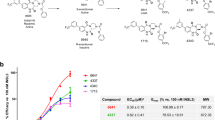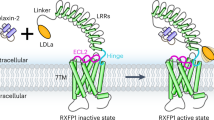Abstract
Relaxin is a pleiotropic hormone which exerts its biological functions through its G-protein coupled receptor, RXFP1. While relaxin is well known for its reproductive and antifibrotic roles, recent studies suggest that it is produced by cancer cells and acts on RXFP1 to induce growth and metastasis. Furthermore, more recently Silvertown et al. demonstrated that lentiviral production of a human gene-2 (H2) relaxin analog reduced the growth of prostate xenograft tumors. The authors proposed that the lentivirally produced peptide was an RXFP1 antagonist; however, the processed form of the peptide produced was not demonstrated. In this study, we have chemically synthesized the H2 relaxin analog, B-R13/17K H2 relaxin, and subjected it to detailed chemical characterization by HPLC, MALDI-TOF mass spectrometry, and amino acid analysis. The biological activity of the synthetic peptide was then tested in three different cell lines. It was found to bind with 500-fold lower affinity than H2 relaxin to RXFP1 receptors over-expressed in HEK-293T cells where it acted as a partial agonist. However, in cells which natively express the RXFP1 receptor, rat renal myofibroblasts and MCF-7 cancer cells, it acted as a full antagonist. Importantly, it was able to significantly inhibit cell invasion induced by H2 relaxin in MCF-7 cells consistent with the results of the lentiviral-driven expression in prostate cancer cells. The relaxin analog, B-R13/17K H2, can now be used as a tool to further understand RXFP1 function, and serve as a template for drug design for a therapeutic to treat prostate and other cancers.





Similar content being viewed by others
References
Baker JG, Hill SJ (2007) Multiple GPCR conformations and signalling pathways: implications for antagonist affinity estimates. Trends Pharmacol Sci 28:374–381
Bani D, Flagiello D, Poupon MF, Nistri S, Poirson-Bichat F, Bigazzi M, Bani Sacchi T (1999) Relaxin promotes differentiation of human breast cancer cells MCF-7 transplanted into nude mice. Virchows Arch 435:509–519
Bathgate RA, Ivell R, Sanborn BM, Sherwood OD, Summers RJ (2006a) International Union of Pharmacology LVII: recommendations for the nomenclature of receptors for relaxin family peptides. Pharmacol Rev 58:7–31
Bathgate RA, Lin F, Hanson NF, Otvos L Jr, Guidolin A, Giannakis C, Bastiras S, Layfield SL, Ferraro T, Ma S, Zhao C, Gundlach AL, Samuel CS, Tregear GW, Wade JD (2006b) Relaxin-3: improved synthesis strategy and demonstration of its high-affinity interaction with the relaxin receptor LGR7 both in vitro and in vivo. Biochemistry 45:1043–1053
Bathgate RAD, Hsueh AJ, Sherwood OD (2006c) Physiology and molecular biology of the relaxin peptide family. In: Neill JD (ed) Physiology of reproduction. Elsevier, San Diego, pp 679–770
Bathgate RA, Lekgabe ED, McGuane JT, Su Y, Pham T, Ferraro T, Layfield S, Hannan RD, Thomas WG, Samuel CS, Du XJ (2008) Adenovirus-mediated delivery of relaxin reverses cardiac fibrosis. Mol Cell Endocrinol 280:30–38
Binder C, Hagemann T, Husen B, Schulz M, Einspanier A (2002) Relaxin enhances in vitro invasiveness of breast cancer cell lines by up-regulation of matrix metalloproteases. Mol Hum Reprod 8:789–796
Binder C, Simon A, Binder L, Hagemann T, Schulz M, Emons G, Trumper L, Einspanier A (2004) Elevated concentrations of serum relaxin are associated with metastatic disease in breast cancer patients. Breast Cancer Res Treat 87:157–166
Büllesbach EE, Yang S, Schwabe C (1992) The receptor-binding site of human relaxin II. A dual prong-binding mechanism. J Biol Chem 267:22957–22960
Callander GE, Thomas WG, Bathgate RA (2009) Prolonged RXFP1 and RXFP2 signaling can be explained by poor internalization and a lack of beta-arrestin recruitment. Am J Physiol Cell Physiol 296:C1058–C1066
Conrad KP, Novak J (2004) Emerging role of relaxin in renal and cardiovascular function. Am J Physiol Regul Integr Comp Physiol 287:R250–R261
Feng S, Agoulnik IU, Bogatcheva NV, Kamat AA, Kwabi-Addo B, Li R, Ayala G, Ittmann MM, Agoulnik AI (2007) Relaxin promotes prostate cancer progression. Clin Cancer Res 13:1695–1702
Feng S, Agoulnik IU, Li Z, Han HD, Lopez-Berestein G, Sood A, Ittmann MM, Agoulnik AI (2009) Relaxin/RXFP1 signaling in prostate cancer progression. Ann N Y Acad Sci 1160:379–380
Hombach-Klonisch S, Bialek J, Trojanowicz B, Weber E, Holzhausen HJ, Silvertown JD, Summerlee AJ, Dralle H, Hoang-Vu C, Klonisch T (2006) Relaxin enhances the oncogenic potential of human thyroid carcinoma cells. Am J Pathol 169:617–632
Hossain MA, Bathgate RA, Kong CK, Shabanpoor F, Zhang S, Haugaard-Jonsson LM, Rosengren KJ, Tregear GW, Wade JD (2008a) Synthesis, conformation, and activity of human insulin-like peptide 5 (INSL5). Chembiochem 9:1816–1822
Hossain MA, Rosengren KJ, Haugaard-Jonsson LM, Zhang S, Layfield S, Ferraro T, Daly NL, Tregear GW, Wade JD, Bathgate RA (2008b) The A-chain of human relaxin family peptides has distinct roles in the binding and activation of the different relaxin family peptide receptors. J Biol Chem 283:17287–17297
Hossain MA, Rosengren KJ, Zhang S, Bathgate RA, Tregear GW, van Lierop BJ, Robinson AJ, Wade JD (2009) Solid phase synthesis and structural analysis of novel A-chain dicarba analogs of human relaxin-3 (INSL7) that exhibit full biological activity. Org Biomol Chem 7:1547–1553
Hoyer D, Boddeke HW (1993) Partial agonists, full agonists, antagonists: dilemmas of definition. Trends Pharmacol Sci 14:270–275
Hsu SY, Nakabayashi K, Nishi S, Kumagai J, Kudo M, Sherwood OD, Hsueh AJ (2002) Activation of orphan receptors by the hormone relaxin. Science 295:671–674
Kamat AA, Feng S, Agoulnik IU, Kheradmand F, Bogatcheva NV, Coffey D, Sood AK, Agoulnik AI (2006) The role of relaxin in endometrial cancer. Cancer Biol Ther 5:71–77
Masterson R, Hewitson TD, Kelynack K, Martic M, Parry L, Bathgate R, Darby I, Becker G (2004) Relaxin down-regulates renal fibroblast function and promotes matrix remodelling in vitro. Nephrol Dial Transplant 19:544–552
Mookerjee I, Hewitson TD, Halls ML, Summers RJ, Mathai ML, Bathgate RA, Tregear GW, Samuel CS (2009) Relaxin inhibits renal myofibroblast differentiation via RXFP1, the nitric oxide pathway, and Smad2. FASEB J 23:1219–1229
Palejwala S, Stein D, Wojtczuk A, Weiss G, Goldsmith LT (1998) Demonstration of a relaxin receptor and relaxin-stimulated tyrosine phosphorylation in human lower uterine segment fibroblasts. Endocrinology 139:1208–1212
Palejwala S, Stein DE, Weiss G, Monia BP, Tortoriello D, Goldsmith LT (2001) Relaxin positively regulates matrix metalloproteinase expression in human lower uterine segment fibroblasts using a tyrosine kinase signaling pathway. Endocrinology 142:3405–3413
Parsell DA, Mak JY, Amento EP, Unemori EN (1996) Relaxin binds to and elicits a response from cells of the human monocytic cell line, THP-1. J Biol Chem 271:27936–27941
Sacchi TB, Bani D, Brandi ML, Falchetti A, Bigazzi M (1994) Relaxin influences growth, differentiation and cell–cell adhesion of human breast-cancer cells in culture. Int J Cancer 57:129–134
Samuel CS, Du XJ, Bathgate RA, Summers RJ (2006) ‘Relaxin’ the stiffened heart and arteries: the therapeutic potential for relaxin in the treatment of cardiovascular disease. Pharmacol Ther 112:529–552
Samuel CS, Hewitson TD, Unemori EN, Tang ML (2007) Drugs of the future: the hormone relaxin. Cell Mol Life Sci 64:1539–1557
Scott DJ, Layfield S, Yan Y, Sudo S, Hsueh AJ, Tregear GW, Bathgate RA (2006) Characterization of novel splice variants of LGR7 and LGR8 reveals that receptor signaling is mediated by their unique low density lipoprotein class A modules. J Biol Chem 281:34942–34954
Silvertown JD, Ng J, Sato T, Summerlee AJ, Medin JA (2006) H2 relaxin overexpression increases in vivo prostate xenograft tumor growth and angiogenesis. Int J Cancer 118:62–73
Silvertown JD, Symes JC, Neschadim A, Nonaka T, Kao JC, Summerlee AJ, Medin JA (2007) Analog of H2 relaxin exhibits antagonistic properties and impairs prostate tumor growth. Faseb J 21:754–765
Sudo S, Kumagai J, Nishi S, Layfield S, Ferraro T, Bathgate RA, Hsueh AJ (2003) H3 relaxin is a specific ligand for LGR7 and activates the receptor by interacting with both the ectodomain and the exoloop 2. J Biol Chem 278:7855–7862
Tashima LS, Mazoujian G, Bryant-Greenwood GD (1994) Human relaxins in normal, benign and neoplastic breast tissue. J Mol Endocrinol 12:351–364
Teerlink JR, Metra M, Felker GM, Ponikowski P, Voors AA, Weatherley BD, Marmor A, Katz A, Grzybowski J, Unemori E, Teichman SL, Cotter G (2009) Relaxin for the treatment of patients with acute heart failure (Pre-RELAX-AHF): a multicentre, randomised, placebo-controlled, parallel-group, dose-finding phase IIb study. Lancet 373:1429–1439
Thompson VC, Morris TG, Cochrane DR, Cavanagh J, Wafa LA, Hamilton T, Wang S, Fazli L, Gleave ME, Nelson CC (2006) Relaxin becomes upregulated during prostate cancer progression to androgen independence and is negatively regulated by androgens. Prostate 66:1698–1709
Vinall RL, Tepper CG, Shi XB, Xue LA, Gandour-Edwards R, de Vere White RW (2006) The R273H p53 mutation can facilitate the androgen-independent growth of LNCaP by a mechanism that involves H2 relaxin and its cognate receptor LGR7. Oncogene 25:2082–2093
Wilkinson TN, Speed TP, Tregear GW, Bathgate RA (2005) Evolution of the relaxin-like peptide family. BMC Evol Biol 5:14
Acknowledgments
This study was funded by a grant to JDW, GWT, and RADB from the National Health and Medical Research Council (NHMRC) of Australia (ID no. 508995). RADB, JDW, and GWT are recipients of Research Fellowship from the NHMRC, while CSS is the recipient of a National Heart Foundation of Australia/NHMRC RD Wright Fellowship. We would like to thank Sharon Layfield and Tania Ferraro for performing the binding and the cAMP assays, Matthias Schulz for technical assistance with the MCF-7 invasion assays, and Ishanee Mookerjee for assistance with the renal myofibroblast differentiation assays.
Author information
Authors and Affiliations
Corresponding author
Rights and permissions
About this article
Cite this article
Hossain, M.A., Samuel, C.S., Binder, C. et al. The chemically synthesized human relaxin-2 analog, B-R13/17K H2, is an RXFP1 antagonist. Amino Acids 39, 409–416 (2010). https://doi.org/10.1007/s00726-009-0454-1
Received:
Accepted:
Published:
Issue Date:
DOI: https://doi.org/10.1007/s00726-009-0454-1




